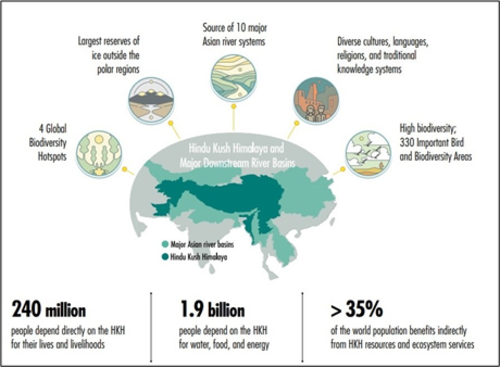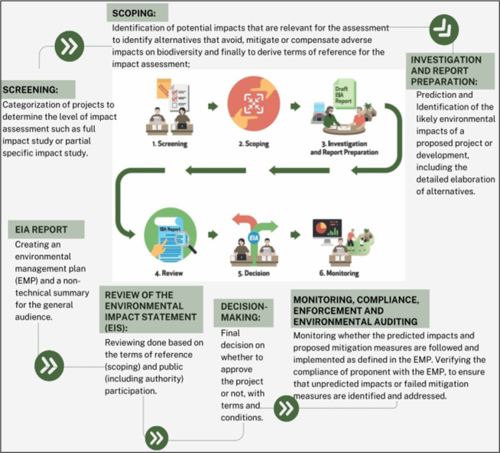The Indian Himalayan Region needs its own EIA
|
"Preserve the Peaks," and "Protect Where the Earth Touches the Sky." |
Relevance: GS I, III (Geography and Environment)
- Prelims: Indian Himalayan Region, Glaciers in Himalaya, Himalayan rivers; Environmental Impact Assessment;
- Mains: Legislative practices of EIA; EIA 2006 notification; EIA 2020 notification; Climate change and environmental standards and policies;
Why in news?
The Teesta dam breach in Sikkim and recent floods and landslides in Himachal Pradesh are stark reminders of our development model which is wreaking our environment and ecology, especially in the Himalayan region.
Why Indian Himalayan Region (IHR) is significant?
- Origin of major Asian rivers: Glaciers of the Himalayas act as a feeding ground for rivers such as the Ganga, and the Brahmaputra. The rivers of the Himalayan region are considered the lifelines of India.
- Considered as a third pole of Earth: This so-called Third Pole (TP) encompasses the Tibetan Plateau, the Himalayas, the Hindu Kush, the Pamirs and the Tien Shan Mountains. Melt-water from ice and snow in the Third Pole feeds many of Asia's large lakes and rivers, including the Indus, Brahmaputra, Ganges, Yellow and Yangtze.

- Production of Hydroelectricity: With its abundant water bodies and ideal topography to utilize the resources for electricity generation, the Himalayan region is regarded as the powerhouse of India. Government estimates show that the Himalayas, with an installed capacity of 46,850 MW, have the potential to generate 115,550 MW.
- Source of Rich Biodiversity: The Himalayan forests are rich in biodiversity with 10,000 species of vascular plants, 13,000 species of fungi and 1100 species of lichens. They provide fuel wood and a large variety of raw materials for forest-based industries.
- Potential Minerals: There is a vast potential for mineral oils in tertiary rocks. Copper, zinc, cobalt, and antimony are known to occur in more than 80-90 locations.
- Safety valve: It has been protecting India since early times. In spite of advancements in modern technology, the defensive role of the Himalayas could not be neglected.
How can we assess the worthiness of any significant human development in terms of its impact on the Environment?
Environment Impact Assessment (EIA): EIA evaluates the inter-related socio-economic, cultural and human-health impacts including both beneficial and adverse of a proposed project or development to be undertaken.
- Objective: To predict environmental impacts at an early stage in project planning and design, find ways and means to reduce adverse impacts, shape projects to suit the local environment and present the predictions and options to decision-makers.
- The legislative practices of EIA may vary according to country but the stages of EIA are as shown below figure:

What can be the role of EIA in protecting IHR?
- Scientific evaluation of Infrastructural Projects:The infrastructural projects could be scientifically evaluated based on the formula of EIA which help in mitigating man-made disaster.
- Early-Warning Systems: With the help of EIA, the government would be easily able to identify the origin of disasters and could deploy EWS to disseminate information and save lives.
- Pan-Himalayan Strategy: Given the seismic fragility of the region, the EIA can create a pan-Himalayan policy to design sustainable projects to maximize the utility of resources
- Sustainable Tourism: Appropriate mechanisms can be formulated to achieve tourism sectoral growth in a sustainable manner.
|
Himalayas under Climate Change: According to a recent IPCC report, the Himalayas are melting at a faster rate and would continue to do so, if adequate mitigating steps are not taken. Given the innumerable benefits originating from the Himalayas, there is a dire need to protect the fragile ecosystem. |
The unique intricacies of Indian Himalayan Region because of which the conventional EIA process is not applicable:
- Loopholes in the law: The EIA 2006 notification has categorized projects under various heads such as mining, extraction, of natural resources and power generation, and physical infrastructure. Unfortunately, the threshold limit beyond which EIA is warranted for all these projects is the same across the country. Even the draft EIA 2020 notification was floated for the public decision not to consider IHR differently.
- Geographical and state-wise consideration: Despite all levels of government being acutely aware of the special needs of the Indian Himalayan Region (IHR), the region's vulnerabilities and fragility have not been considered. Some industries mentioned in the schedule for the notification cannot be set up in the IHR states due to the industrial policies of their respective states.
- Flaws in current Graded-approach: The Indian regulatory system uses a graded approach where a differentiated risk management approach just depends on whether a project is coming up within a protected forest, a reserved forest, a national park, or a critical tiger reserve.
- Remains merely a ‘box ticking’ mechanism: In many cases, the EIA is considered as a mere formality that needs to be done for Environmental clearance before the project can be started. Secondly, there is no regulator at the national level, as suggested by the Supreme Court in 2011 in the N Godavarman case to carry out an independent, objective and transparent appraisal and approval of the projects of Environmental clearances.
Way Ahead:
- Need for Strategic Environmental assessment: Policymakers can do well to explore other tools such as the strategic environmental assessment which takes into account the cumulative impact of development in an area to address the needs of the IHR as a fundamental policy.
- Need for the categorization of projects and decision-making: While categorizing developmental projects it is important that the impacts of all such projects and activities are seen in the IHR in the context of this region’s fragility and vulnerability considering its ecology and environment.
- Need for a different set of Environmental standards: Climate change has added another layer of vulnerability to the glacial ecosystem. Understanding the fragility and vulnerability of the Himalayas, there is a need for a different set of environmental standards if the project is located in IHR.
BEYOND EDITORIAL:
|
Salient features of 2006 Amendments to EIA Notification:
|
PYQs
Mains:
- How does the draft Environment Impact Assessment (EIA) Notification, 2020 differ from the existing EIA Notification, 2006? (2020)
- Environmental Impact Assessment studies are increasingly undertaken before a project is cleared by the Government. Discuss the environmental impacts of coal-fired thermal plants located at coal pitheads. (2014)
- Bring out the relationship between the shrinking Himalayan glaciers and the symptoms of climate change in the Indian sub-continent. (2014)
Prelims:
The Himalayan Range is very rich in species diversity. Which one among the following is the most appropriate reason for this Phenomenon? (2011)
- It has a high rainfall that supports luxuriant vegetative growth.
- It is a confluence of different bio-geographical zones.
- Exotic and invasive species have not been introduced in this region.
- It has less human interference.


